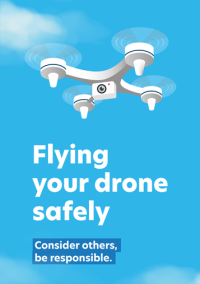Unmanned aircraft, often known as drones, are very popular for recreational and business use.
When we talk about unmanned aircraft this includes remotely-controlled model aircraft, kites, and others covered by Part 101 Gyrogliders and Parasails, Unmanned Aircraft (including Balloons), Kites, and Rockets - Operating Rules.
But remember, these unmanned aircraft can be a hazard to people, property, and traditional aircraft. So it’s important to know the rules before you fly.
 Flying your drone safely
Flying your drone safelyA drone is an aircraft, so if you fly one, you’re a pilot. Being the Pilot in Command of a drone, you have the same responsibilities under the Civil Aviation Act 2023 that you would have if you were physically on board the aircraft. As the Pilot in Command you are responsible for the safe operation of the drone and the safety of any cargo on board (Sections 13 and 14 of the Act).
New brochure: Flying your drone safely [PDF 8.4 MB]
We've gathered together some common questions about flying unmanned aircraft in New Zealand.
Drones and unmanned aircraft must follow the law as set out in the Civil Aviation Act 2023.
We highly recommend that you attend a training course to fly your drone. This will increase your awareness of the rules and airspace, as well as enhance your flying skills. And that's going to benefit the safety of everyone.
Information to help you operate unmanned aircraft safely.
Information about using radio frequencies, aeronautical voice frequencies, and ADS-B OUT for drones.
We encourage anyone who has a concern about drone safety to make a report.
If an offence is alleged to have been committed, under the Civil Aviation Act 2023 (Sections 18 and 19), the CAA or Police can require the operator of the drone to provide all information that may help identify the pilot in command, and it is an offence to withhold relevant information.
Quick find links to key drones-related information, including forms and Advisory Circulars.
Part 102 Unmanned Aircraft Operator Certification
Certificated organisations are permitted to use the CAA logo with certain conditions. Please see our Permission to use the CAA logo page for more information.
Please consider investing in your own knowledge and skills by undertaking a drone pilot course.